Aspic [noun]: A clear jelly typically made of stock and gelatin and used as a glaze or garnish or to make a mold of meat, fish, or vegetables.
Gelatin [noun]: A jelly made with gelatin, used as a dessert or salad base.
If you peruse cookbooks from the 1950s, you’ll find a ton of recipes featuring aspic and gelatin. Many of us, today, find many of these recipes, well, repulsive. For example:
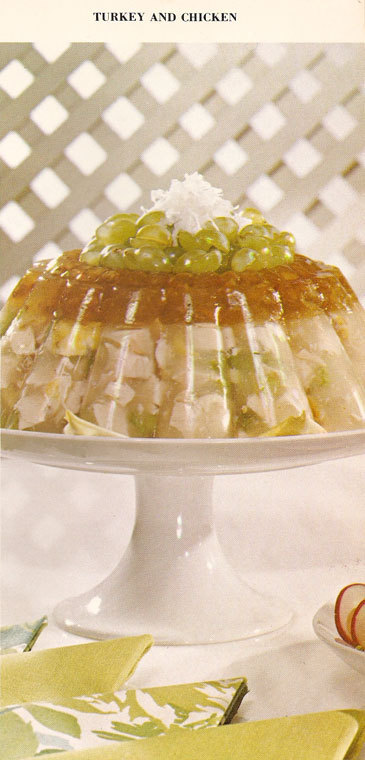
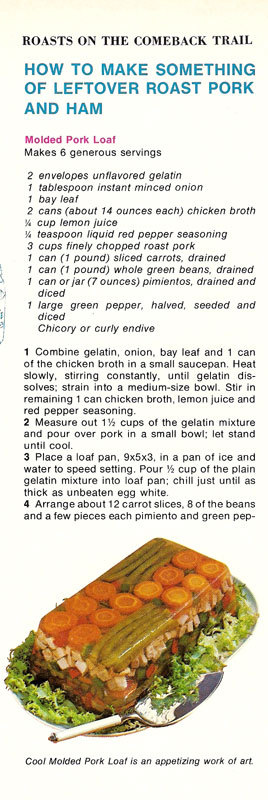
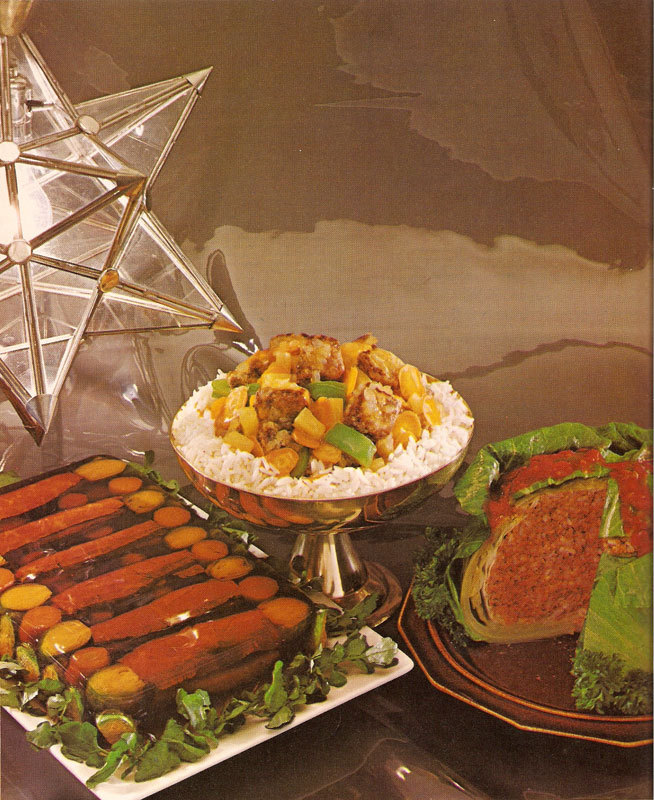
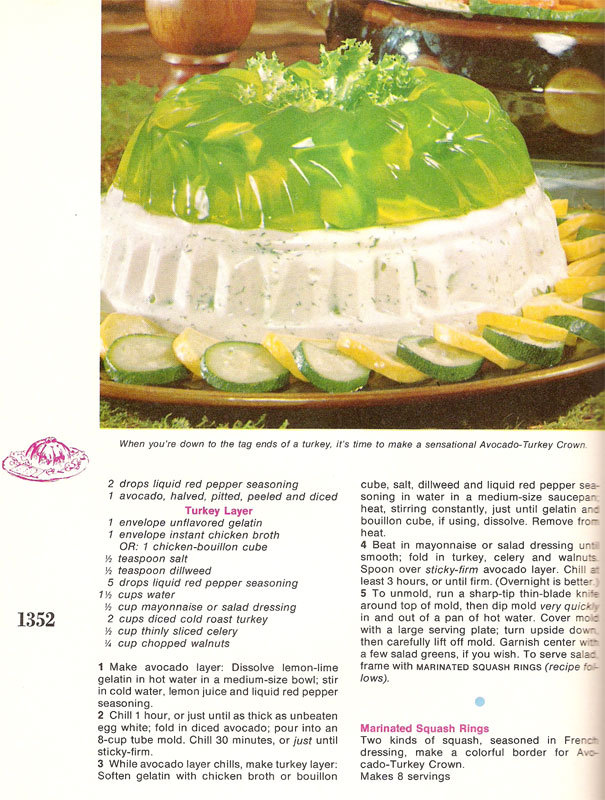
My friend, Emily, had a Mrs. Beeton party and I made avocado lime gelatin with mayonnaise (left), but it lost the competition for nastiest dish to the Cucumber Au Gratin (center):
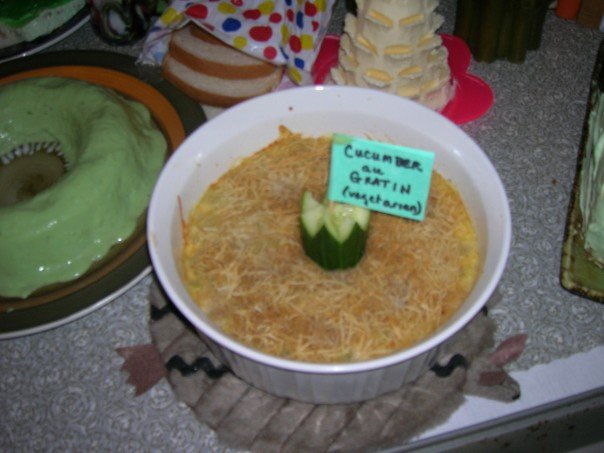
Here is the cover of a cookbook devoted to “gel cookery”:

Was it just a fad? It turns out, no. It was status. Or so says a blogger at The Good Old Days:
We’ve all wondered what the hell could motivate someone to [prepare, serve, and eat so many gel-based foods] — well, it was simply so they could brag about owning a refrigerator. You can’t solidify gelatin without refrigeration, and so you couldn’t serve Jellied Bouillon with Frankfurters unless you were above a certain income level… So people started jellying vegetables, meats, salads, cream, and pretty much everything in their kitchen.

Comments 79
Zoe — February 15, 2009
Not just the ownership of a fridge - dishes set in aspic were a huge part of classical French cookery. I've just been reading this book by Stephen Mennell where he describes one grand dinner with 52 cold items, every one of them using aspic.
Makes you wonder how regular they were ...
Dangger — February 15, 2009
These are not so bad. I've tried them before.
eallen — February 15, 2009
Given the large text on HOW TO MAKE SOMETHING OUT OF LEFTOVER PORK AND HAM, I wonder if some of these aspic recipes were exploiting the same WWII mentality of frugality, rationing and "using it up."
genderkid — February 15, 2009
This fad reached Argentina in the '60s via television; everyone had refrigerators by then, so it doesn't seem related to having one. Actually, it might have been about a different kind of status: owning a TV set, or imitating foreign habits.
yikes — February 15, 2009
So at a Mrs. Beeton party, the point is to make gross foods and laugh about it?
What a waste of an avocado.
Penny — February 15, 2009
You also had to own the molds for such dishes--and store them--in tiny mid-century kitchens, that wasn't a trivial investment of space.
I wonder too if there was something appealing about the shiny surfaces, bright colors and streamlined shapes of these. Think Fiesta ware and bakelite jewelry, in edible form....
anna — February 15, 2009
this probably has something to do with that joke about bringing jello molds to the new neighbors that came up sometimes when i was a kid... weird 60s cultural residue seeping in to the early 90s...
Robin — February 15, 2009
Related to what Zoe said above, the French catering company I worked in had about 3 cookbooks lying around (mostly the chef cooked from memory, these were for inspiration) and one of them was filled entirely with terrine recipes. Terrines are still relatively popular in France, and while they don't always include gelatin, there were quite a few in the cookbook that looked very much like the aspic dishes in the first three pictures.
egypt » Blog Archive » Sociological Images » THE ICKY ERA OF ASPIC — February 15, 2009
[...] Commonground wrote an interesting post today onHere’s a quick excerptvisitor map. Locations of visitors to this page · Site Meter. RSS Links. All posts · All comments. subscribe by email. Enter your email address:. Delivered by FeedBurner. Archives. Select Month, February 2009 (41), January 2009 (85) … [...]
atalised — February 16, 2009
that is really, really interesting. now i think i understand why a.)my grandma is soooo into jello and b.) why there is always things in it.
Jay Livingston — February 16, 2009
When are these recipes from? I couldn't find it on the source page either. They look 1950s-ish. But by then refrigerators were commonplace, just like in Argentina in the 60s (@genderkid). I think the appeal of these aspic recipes:
1, They are all made ahead of time and require no prep just before serving.
2. They use convenience foods -- almost no fresh vegetables that have to be prepared.
3. They look like something. They have a controlled, set form or shape. They're not just a pile of food heaped on a plate.
4. In contrast to the conspicuous consumption idea (refrigerator = wealth), these recipes use leftover meat. The appeal is to the homemaker who wants to economize.
jane — February 17, 2009
I love the gelatin that forms when making broth. I can see how these might taste good. Just because they're not common anymore doesn't necessarily mean they're nasty.
Swings & Skateboards — February 26, 2009
[...] on this at the excellent Sociological Images blog, here [...]
greg — March 2, 2009
I think you're seeing too much into it. Gelatin ("la gelee") is a common ingredient in french cooking (and probably english and all over europe), it has been in use since the middle ages as it is a common artefact of cooking meat.
I guess the social context here is just the "american one".
Quercki M. Singer — March 16, 2009
In the notes for the painting by Joseph A. Harrington, "Jules Harder, First Chef of the Palace Hotel," 1874 it says that gelatin was hard to make so he was showing off his prowess as a chef. This painting is part of the permanent collection at the Oakland Museum of California.
Jules Harder, First Chef of the Palace Hotel
I like it because it's an impressive gelatin mold.
Sighter — August 6, 2009
I figured I'd ask my grandmother about this, 'cause, well, she did her time as a 50s housewife.
She wasn't familiar with the term aspic, but when I described it, she said, "Oh, of course. Yeah, there were people who did that, but I never did because it tasted nasty."
Lee Davis-Thalbourne — August 6, 2009
I recall reading an interesting factoid that during the medieval period, they often cooked meat and kept it in Aspic, not for any presentation reason (although that was probably a part of it), but because the Aspic provided a layer of protection against air, helping to preserve the meat. While the Aspic would probably eventually spoil, the meat inside would resist spoiling for a great deal longer. And traditional aspics had the additional benefit of not needing refrigeration to keep, so it was a nicely low-tech preservation method.
While it's unlikely that this is the reason Gel-based cookery became so popular in the 50s, it's worth noting that Gels don't degrade particularly quickly in the refrigerator, either. The very dry air in refrigerators usually just causes a slight skin on the outside of the gel mold, which preserved everything inside just fine. So, Gelatin leftovers could be happily stored in the fridge for quite a while without needing covering.
thewhatifgirl — August 9, 2009
I, too, want to challenge the idea that this had anything to do with refrigerators. A few years ago, I found a cookbook at my grandmother's house that included tons of aspic recipes but the cookbook was from 1908 - all of the cooking directions were for wood-burning stoves.
Craig — September 4, 2009
My wife reports that Aspics remain huge in France; I think they're perfectly revolting. I tried making chaud-froid of chicken breasts and eggs in aspic with tarragon out of Mastering the Art of French Cooking, and I couldn't eat either of them. Cold chicken is superb on a salad. And why would anyone go to the trouble of chilling a poached egg, when it takes ten minutes to make and is one of the most delicious things on earth piping hot?
Tastes change--my classic "Joy of Cooking" from the 1960's reports that an aspic is _the_ way to prepare leftovers of almost any kind. Fried rice or an omelet for me, please.
JELL-O For Salads! » Sociological Images — September 20, 2009
[...] See also our post on aspic, meat-flavored gelatin foods. [...]
cdthomas — September 22, 2009
Wow, no one's read Perfection Salad, the definitive history of 'sanitary' white foods, home economics, reform movements and social hygiene?
http://www.amazon.com/Perfection-Salad-Cooking-Century-Library/dp/0375756655
Recall that gelatin is *protein*, pretty useful and moldable protein, at that. If you wanted to give your family extra nutrition while using leftovers, either you made a casserole, or salads with meat/cheese bits. Gelatin allowed for art as well as nutrition in a time when people wasted nothing.
head cheese. « inexhaustible, inviting — January 28, 2010
[...] but a meat jelly made with pieces from the head of a calf or pig (sometimes a sheep or cow) in aspic. It may contain onion, black pepper, allspice, bay leaf, salt, and vinegar. It may also include [...]
Marianne — February 11, 2010
We still have these in Norway. My aunt made one for me in my Christening in 2002. I don't see the problem. (Cue some 1950's background music) They are nice and tasty and require no hazzle in the kitchen when the guests needs to be entertained.
Katherine — February 11, 2010
While I appreciate the ick-factor for folks unaccustomed to eating savoury gellied-things, I don't think it is quite fair or open-minded to declare the whole enterprise well, gross.
Both my Finnish grandfather on the one side of the family, and my Estonian grandmother on the other would make a dish around christmas each year that was a jellied meat salad/loaf-like sort of thing. I believe it was made from boiling a pig's head, and adding extra pork meat, seasonings, etc. It went by the rather unappetizing name of 'head-cheese' in English, and for the life of me I can't recall either the Finnish or Estonian words.
It was really tasty, if rather salty. The meat inside was always very tender, and it kept in the fridge for a long time.
I understand that it is currently in vogue for white, middle class liberals like myself to espouse the value of 'whole foods' and sneer at convenience foods like jello as 'fake food' - and I usually do. But when this impulse leads us to sneer at traditional/ethnic cuisine as gross, we might just be going too far.
Ham and Jelly, Together at Last » Sociological Images — March 17, 2010
[...] more fun food-related examples of social construction, see our posts on meat-flavored gelatin, savory veggie jell-o, vitamin beer, cucumber flavored soda, soup for breakfast, and 7Up [...]
Flavor as Culture Specific » Sociological Images — June 4, 2010
[...] we posted a cross-cultural example (soup for breakfast in South Korea) and historical examples (mmm aspic, 7-Up with milk, and prunes are for kids!). On Shakesville, Deeky posted this photograph of ice [...]
Flora Steele — May 8, 2011
Enjoyed the good discussion!
Yes, what's wrong with something that before use keeps forever in the cupboard, uses leftovers, does not have to be served hot or fresh out of the whatever, keeps a long time afterward, adds protein, and has sfaik no carbs?
Okay, that sounds like it shouldn't be a real food, but it is.
If gel per se seems icky, do you not eat gelatin desserts either?
[ISTP] Why'd you choose that avatar? — October 27, 2011
[...] [...]
guest — January 21, 2012
Is that a cigarette laying to the side of the "cool molded pork loaf"?
Tim — November 27, 2013
I think aspics are wonderful. That was the era of aspic abuse.
Petro, Colombia Moments and the Ineffectual President » Richard McColl Richard McColl — April 23, 2014
[…] and perhaps worst of all, no debate. Politics here is now officially the culinary equivalent of aspic. It’s […]
What will the reviewers think of next? Clean and Green? XXXX | Odell House News — May 1, 2014
[…] http://thesocietypages.org/socimages/2009/02/15/the-icky-era-of-aspic/ […]
Honestly, we don’t serve breakfast! Never have. | Odell House News — May 11, 2014
[…] I actually have seen a version of this done in Germany, but that is another story. And because you asked, here is the link back to a fun article and source for picture above: http://thesocietypages.org/socimages/2009/02/15/the-icky-era-of-aspic/ […]
“Oh, Jennifer . . . just what I’ve always wanted . . .” – Christmas | Real Proper — September 29, 2014
[…] the spirit of peace and tolerance” the ladies agree to make him a dish. And what a dish! A savory aspic mousse made with boiled eggs and decorated with olives, selected by Jennifer because “all that sixties […]
ferna — October 19, 2015
looks like something taken out of a Lovecraft's story.
sbignewski — January 3, 2016
Reasonable theory, but doubt it's correct. The 1950's were about 30 years too late for refrigerators to have been a status symbol in the U.S. and, as pointed out below, aspic was very often made from leftovers.
Jennifer Comstock — October 15, 2016
If this were just about housewives bragging that they had a refrigerator, this need could have been satisfied many other ways--eg, serving any cold food.
I think this was for purely aesthetic reasons.
Dan Shumway — November 8, 2016
I have a faint recollection of some kind of gelatin salad and the term aspic was mentioned. All I remember was I hated it!
Caroline — November 13, 2016
I enjoy homemade headcheese. My uncle used to make his own - from pork but also beef or game meat. He also made fabulous beet/horseradish relishes and slivovitz.
Homemade headcheese can be flavored up many ways. And if set harder makes a great sandwich meat. ----- no criticism from me.
I also like aspics , especially one green tangy coleslaw type. Of course one can get carried away trying to be "creative" rather than just good cooking.
kevin Nash — January 2, 2017
I think that meat or poultry aspics are made the same way as a broth or stock basicly. Bones of veal and beef are used with some beef feet and chicken feet for extra thickening action. Onion,carrots and leeks are used , along with some cellery ,salt and pepper. This all gets clarified with egg whites and some lean ground beef the strained through cheesecloth.
Nothing unusual about this aspic. Nothing in it but old fashion scratch cooking.
Henry Michel regarde Top Chef : Le grand tour de chauffe | MUNCHIES — January 25, 2017
[…] COMPLEMENT MULTIMEDIA : Retour sur l’ère de l’Aspic […]
Ilia Shrago — May 25, 2017
Speak for yourselves and get enough of a life to become curious about foreign cultures, you condescending C students. Aspic has been an integral part of many cuisines (Russian among them) for centuries and it is absolutely delicious when properly prepared. It is a means of preserving soup in cold weather (which is a large part of the year in some places, as you'd have known if you had ever bothered to open an geographical atlas), as well as a means of making a delicious first course into an even more delicious second course with a traditional shortage of food and funds, characteristic to poor, peasant cuisines all over the world. It is delightful if you use proper old recipes and good ingredients. My own mother makes sturgeon in aspic at home, and there's a reason that dish costs beaucoup bucks in high-class restaurants.
JohnTomato — May 25, 2017
As a method to use every scrap of meat or veg it worked. Food was expensive in the 1950s and a thrifty homemaker wasted nothing.
Masterskrain — May 25, 2017
Um...Turkey Jell-o. No. Just no.
There’s no such thing as a free lunch. Unless you’re elected. – Ashley Tanton — June 23, 2017
[…] it would appear, we are set in aspic and we will continue to burden the people of Hythe with the extraordinary cost of blessing the […]
Xavier Heuss — July 21, 2017
This is actually a sort of "show-off" dish... but it isn't even from the 50's or 60's. It's much much older than that (think 1800s France and England). They didn't use gelatin in the way we know it today, but they used bone marrow to thicken/jelly stock (much like gelatin). The process was very elaborate, as stock first needed to be clarified (like making bouillon or consomme) and then adding bone marrow and cooking with bones, then adding the meats and vegetables or whatever they used.
Most of these dishes called "aspics" were reserved for either people who could afford to have a dedicated cook and a large kitchen with many utensils, fire wood, an oven (which was INCREDIBLY expensive back then, as it was made entirely of iron). The average lower class person could not afford an oven (they had to ask a bakery to bake their things and pay them).
So, yes, this was a 'status' 'show-off' dish in the 50's and 60's, because of it's reputation from the previous two centuries, but of course... knox really ruined the art form that this was by making it a 5 minute process, and cheap.
Also, ovens are pretty inexpensive now (about 1k). Back then an oven would be about 10k (from our time), and also consider that the lower classes earned 40 times less than we do now (minimum wage), and that rights were almost non-existent, there was much division socially, and you only had two types of people (incredibly poor, and incredibly rich), the middle class is still relatively new, although much more common now and probably most of us are middle class (100k-300k per year).
Back then the average person lived on 5dlls a month (from our time) and their diets were mainly of light gruels, thinly sliced bread with a little butter and a very weak tea. An aspic with meat and vegetables would have been a truly luxurious dish which would cost more than their monthly income (France / England)
I actually like aspics. A properly made aspic is absolutely delicious (much like a terrine or pate, which is also served cold, but the aspic is not as hearty as the pate or terrine, or nearly as flavorful or expensive, but still is a wonderful light beginning to an informal meal)
An aspic would be an entree, and not a main dish. Meaning you only get a small serving at the beginning of a meal (3 or 5 course meal). The secret to making a great tasting aspic is to have a flavorful well seasoned stock, tender and well seasoned meat, tender and well seasoned vegetables, and the correct stock and clear-fat ratio for the jelly to be soft and buttery but clear, instead of hard and bland like your typical lazy American housewife 5-minute jello garbage.
Hope this answers most questions. Toodle-oo *waves goodbye*
Sir Louie — October 14, 2017
Actually, the reason they used aspic is as old as cooking. It sealed the foods from airborne bacteria in a day when refrigeration meant a block of ice in cabinet. Go through any old (1800's) and you can find recipes for aspic dishes. Victorian aspic molds are found in antique shops now, but at one time they were much treasured kitchen tools.
The gelatin you made was an inferior type, starting with a packet. A proper aspic starts with the source of the gelatin: bone broth. That's right, starting from scratch with hooves, trotters, tails, all the parts that are rich in collagen. But all that is a pain, and unless you're a patient chef, most people won't do it.
Andrew — October 17, 2017
Aspics have been around for as long as boiled meat has, but I suspect that the mid-20th century American trend for gelatin molds was mostly a creation of advertising. Homemaking magazines were hugely influential, and when I looked back at my grandmother's collection from the 1960s I noticed one of the biggest advertisers was Jell-O. Like many other industrial food companies, they commonly featured recipes in their ads to drive sales of the product.Jell-O flavors once included tomato, mixed vegetable, and "Italian salad" - which probably were as gross as they sounded but they would have made savory gelatin dishes like those shown above much seem easier for a home cook to prepare. I'm not sure they were ever beloved, but for a time the magazines made them seem normal. (The presentations shown above seem like their era's version of Instagram food - more for show than for taste).
Notably, the US homemaking magazines still featured savory gel molds for decades after refrigerators became standard amenities rather than status symbols. It's possible that Jell-O was the main cultural force that killed the taste for aspic in the US, as most Americans now associate the texture of jelly exclusively with desserts. In many parts of Europe, where flavored gelatin powders aren't a supermarket staple, meat in aspic is still quite common and often delicious.
Chef Carolyn — December 9, 2019
It's about nutrition! The same reason why people are making and consumming bone broth today. The healthy part of brone broth is the gelatin- it just happens to be heated into a liquid. If your bone broth doesn't gel when refrigerated, then it's not a good bone broth. Aspic was a different and interesting way to use the gelatin other than a soup.
Tom Walker — December 30, 2019
We still have headcheese, souse, and at one time jellied beef was sold on the cold cuts dept of the Piggly Wiggly supermarket in Sheboygan Wisconsin
Own the Recipes of Georgia O’Keeffe - MastComm — February 7, 2020
[…] Some of O’Keeffe’s recipes are remnants of the baroque thrills of early-20th-century entertaining. An île flottante — an elaborate dessert made from meringue floating in crème anglaise, a custard — might have been prepared only for guests, Mr. Caldwell said. A tomato aspic — one of the first recipes in the alphabetically organized box — is a throwback. […]
Own the Recipes of Georgia O’Keeffe | Media One — February 7, 2020
[…] Some of O’Keeffe’s recipes are remnants of the baroque thrills of early-20th-century entertaining. An île flottante — an elaborate dessert made from meringue floating in crème anglaise, a custard — might have been prepared only for guests, Mr. Caldwell said. A tomato aspic — one of the first recipes in the alphabetically organized box — is a throwback. […]
Own the Recipes of Georgia O’Keeffe - INSIDERSPIRIT — February 7, 2020
[…] Some of O’Keeffe’s recipes are remnants of the baroque thrills of early-20th-century entertaining. An île flottante — an elaborate dessert made from meringue floating in crème anglaise, a custard — might have been prepared only for guests, Mr. Caldwell said. A tomato aspic — one of the first recipes in the alphabetically organized box — is a throwback. […]
Break'n News - World and US News, Headlines, busines, politics and more — February 7, 2020
[…] Some of O’Keeffe’s recipes are remnants of the baroque thrills of early-20th-century entertaining. An île flottante — an elaborate dessert made from meringue floating in crème anglaise, a custard — might have been prepared only for guests, Mr. Caldwell said. A tomato aspic — one of the first recipes in the alphabetically organized box — is a throwback. […]
Own the Recipes of Georgia O’Keeffe | 101News.Net101News.Net — February 7, 2020
[…] Some of O’Keeffe’s recipes are remnants of the baroque thrills of early-20th-century entertaining. An île flottante — an elaborate dessert made from meringue floating in crème anglaise, a custard — might have been prepared only for guests, Mr. Caldwell said. A tomato aspic — one of the first recipes in the alphabetically organized box — is a throwback. […]
Own the Recipes of Georgia O’Keeffe - Street style — February 7, 2020
[…] Some of O’Keeffe’s recipes are remnants of the baroque thrills of early-20th-century entertaining. An île flottante — an elaborate dessert made from meringue floating in crème anglaise, a custard — might have been prepared only for guests, Mr. Caldwell said. A tomato aspic — one of the first recipes in the alphabetically organized box — is a throwback. […]
Own the Recipes of Georgia O’Keeffe – VIP Fitness — February 8, 2020
[…] Some of O’Keeffe’s recipes are remnants of the baroque thrills of early-20th-century entertaining. An île flottante — an elaborate dessert made from meringue floating in crème anglaise, a custard — might have been prepared only for guests, Mr. Caldwell said. A tomato aspic — one of the first recipes in the alphabetically organized box — is a throwback. […]
Own the Recipes of Georgia O’Keeffe - ExpressMirror — February 10, 2020
[…] Some of O’Keeffe’s recipes are remnants of the baroque thrills of early-20th-century entertaining. An île flottante — an elaborate dessert made from meringue floating in crème anglaise, a custard — might have been prepared only for guests, Mr. Caldwell said. A tomato aspic — one of the first recipes in the alphabetically organized box — is a throwback. […]
Own the Recipes of Georgia O’Keeffe – HNM — February 10, 2020
[…] Some of O’Keeffe’s recipes are remnants of the baroque thrills of early-20th-century entertaining. An île flottante — an elaborate dessert made from meringue floating in crème anglaise, a custard — might have been prepared only for guests, Mr. Caldwell said. A tomato aspic — one of the first recipes in the alphabetically organized box — is a throwback. […]
Owner of Georgia O'Keefe's Recipes — February 14, 2020
[…] Some of O’Keeffe’s recipes are the remains of an entertaining baroque thrill in the early twentieth century. A I amLe Florentine – Mr. Caldwell said, an elaborate dessert, a custard made from floating marijuana in cream Anglaise – could only be prepared for guests, Mr Caldwell said. A tomato aspic – one of the first recipes in the box in alphabetical order – is Return. […]
A Stoner’s Guide to Trippy, Jiggly Jelly Cake Art - The 1ml Store CBD oil uk — March 10, 2020
[…] It burgeoned as a US cooking trend in the 1950s and didn’t really go away until after the ‘80s; whole meals were encased in jelly in almost surrealist, alien-like spreads that practically screamed […]
A Stoner's Guide to Trippy, Jiggly Jelly Cake Art | stonejack — March 10, 2020
[…] It burgeoned as a US cooking trend in the 1950s and didn’t really go away until after the ‘80s; whole meals were encased in jelly in almost surrealist, alien-like spreads that practically screamed […]
A Stoner’s Guide to Trippy, Jiggly Jelly Cake Art – Canna Hope — March 10, 2020
[…] It burgeoned as a US cooking trend in the 1950s and didn’t really go away until after the ‘80s; whole meals were encased in jelly in almost surrealist, alien-like spreads that practically screamed […]
A Stoner’s Information to Trippy, Jiggly Jelly Cake Artwork - WeedlyUpdate — March 10, 2020
[…] as a US cooking development within the 1950s and didn’t actually go away till after the ‘80s; complete meals had been encased in jelly in virtually surrealist, alien-like spreads that virtually screamed […]
A Stoner’s Guide to Trippy, Jiggly Jelly Cake Art – CBD QUALITY CARE — March 10, 2020
[…] It burgeoned as a US cooking trend in the 1950s and didn’t really go away until after the ‘80s; whole meals were encased in jelly in almost surrealist, alien-like spreads that practically screamed […]
A Stoner’s Guide to Trippy, Jiggly Jelly Cake Art – WIN WITH THIS — March 11, 2020
[…] It burgeoned as a US cooking trend in the 1950s and didn’t really go away until after the ‘80s; whole meals were encased in jelly in almost surrealist, alien-like spreads that practically screamed […]
A Stoner’s Guide to Trippy, Jiggly Jelly Cake Art – Weedz Magazine — March 11, 2020
[…] It burgeoned as a US cooking trend in the 1950s and didn’t really go away until after the ‘80s; whole meals were encased in jelly in almost surrealist, alien-like spreads that practically screamed […]
Rosie — April 5, 2020
Many butchers here in France are also delicatessens/caterers, & an egg with ham in aspic or ham stuffed with liver paste with veggies in aspic are very common in their shops. In fact, I bought an egg wrapped in ham in aspic today for my lunch! A quick, light flavorful appetizer with a glass of rosé—nothing like it! If I'd really wanted to go whole hog, I'd've put it on top of a lettuce leaf or two… But that would've meant bending over & opening the veggie drawer…
The Polarizing Appeal of Clear Things - ViralDome - Best Your Stories On The Web — May 13, 2020
[…] which encased meat or shrimp or vegetables in a wobbly layer of gelatin, are often seen as an “icky” oddity of the past; a Facebook group called “Aspics with threatening auras” markets […]
Julia — December 24, 2020
I doubt it has to do with fridges as well. This dish goes really far back. And just think of the nutritional content!!! It prevents from arthritis and bone damage. It strengthens the tendons and ligaments. It's a great source of fat and protein (complies with Keto, whole30, and Paleo). It is rather filling, on the practical note. It also has all of the health properties of bone broth, which are numerous. I think this is a matter of a very healthy meal, since they ate collagen rather than supplementing it.